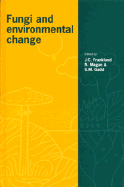Book contents
- Frontmatter
- Contents
- List of contributors
- Preface
- 1 Effects of climate change on fungal diseases of trees
- 2 Effects of climate change on Fusarium foot rot of winter wheat in the United Kingdom
- 3 Effects of UV-B radiation (280–320 nm) on foliar saprotrophs and pathogens
- 4 Implications of global warming and rising sea-levels for macrofungi in UK dune systems
- 5 Red Data Lists and decline in fruiting of macromycetes in relation to pollution and loss of habitat
- 6 Effects of dry-deposited SO2 and sulphite on saprotrophic fungi and decomposition of tree leaf litter
- 7 Effects of atmospheric pollutants on phyllosphere and endophytic fungi
- 8 Influences of acid mist and ozone on the fluorescein diacetate activity of leaf litter
- 9 Mycorrhizas and environmental stress
- 10 Myccorhizas, succession, and the rehabilitation of deforested lands in the humid tropics
- 11 Potential effects on the soil mycoflora of changes in the UK agricultural policy for upland grasslands
- 12 Uptake and immobilization of caesium in UK grassland and forest soils by fungi, following the Chernobyl accident
- 13 Effects of pollutants on aquatic hyphomycetes colonizing leaf material in freshwaters
- 14 Fungi and salt stress
- 15 Fungal sequestration, mobilization and transformation of metals and metalloids
- 16 Urban, industrial and agricultural effects on lichens
- 17 Fungal interactions with metals and radionuclides for environmental bioremediation
- 18 Impact of genetically-modified microorganisms on the terrestrial microbiota including fungi
- 19 Has chaos theory a place in environmental mycology?
- Index of generic and specific names
- Subject index
16 - Urban, industrial and agricultural effects on lichens
Published online by Cambridge University Press: 05 November 2011
- Frontmatter
- Contents
- List of contributors
- Preface
- 1 Effects of climate change on fungal diseases of trees
- 2 Effects of climate change on Fusarium foot rot of winter wheat in the United Kingdom
- 3 Effects of UV-B radiation (280–320 nm) on foliar saprotrophs and pathogens
- 4 Implications of global warming and rising sea-levels for macrofungi in UK dune systems
- 5 Red Data Lists and decline in fruiting of macromycetes in relation to pollution and loss of habitat
- 6 Effects of dry-deposited SO2 and sulphite on saprotrophic fungi and decomposition of tree leaf litter
- 7 Effects of atmospheric pollutants on phyllosphere and endophytic fungi
- 8 Influences of acid mist and ozone on the fluorescein diacetate activity of leaf litter
- 9 Mycorrhizas and environmental stress
- 10 Myccorhizas, succession, and the rehabilitation of deforested lands in the humid tropics
- 11 Potential effects on the soil mycoflora of changes in the UK agricultural policy for upland grasslands
- 12 Uptake and immobilization of caesium in UK grassland and forest soils by fungi, following the Chernobyl accident
- 13 Effects of pollutants on aquatic hyphomycetes colonizing leaf material in freshwaters
- 14 Fungi and salt stress
- 15 Fungal sequestration, mobilization and transformation of metals and metalloids
- 16 Urban, industrial and agricultural effects on lichens
- 17 Fungal interactions with metals and radionuclides for environmental bioremediation
- 18 Impact of genetically-modified microorganisms on the terrestrial microbiota including fungi
- 19 Has chaos theory a place in environmental mycology?
- Index of generic and specific names
- Subject index
Summary
Introduction
Lichens have acquired a reputation as valuable monitors of environmental pollution. Pollution gradients have been related either to differential species sensitivity, creating characteristic floristic changes, or to the capacity of lichens to acquire and retain specific chemicals. These properties may be partly related to the nature of the lichen symbiosis and the structure of the resulting thallus. A brief review of lichen biology is provided to explain how the symbionts interact, what structural and physiological flexibility may exist and how far lichens react to the temporal and spatial heterogeneity of the natural, uncontaminated environment. Reference has been made to a number of valuable reviews that quote a wider literature.
Lichen biology
The lichen symbiosis consists of a fungal component, acting as the interface with the environment, and a photosynthetic component that is to a greater or lesser extent surrounded by the fungal tissues. Ascomycotina represent the main fungal group comprising the lichens, although Basidiomycotina and Deuteromycotina also occur frequently (Hawksworth, 1988a). More than 40% of the Ascomycotina are lichenized and some genera have both free-living and lichenized members. Whereas the photosynthetic component is usually either cyanobacterial or chlorophycean, thalli with both types of photobionts in different regions of the same thallus also occur (Hawksworth, 1988b; Tschermak-Woess, 1988). There is still doubt as to whether certain commonly lichenized chlorophycean algae, particularly the genus Trebouxia, exist in the free-living condition (Ahmadjian, 1993).
- Type
- Chapter
- Information
- Fungi and Environmental Change , pp. 257 - 281Publisher: Cambridge University PressPrint publication year: 1996
- 2
- Cited by

